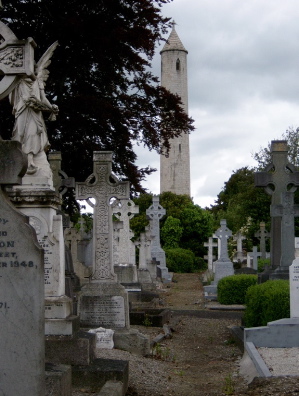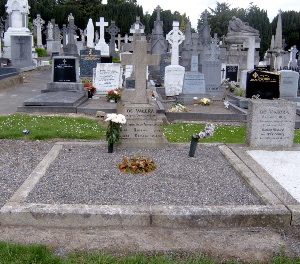Glasnevin Cemetery
|
|
Glasnevin Cemetery is the main Catholic cemetery in Dublin, the capital of Ireland.

Glasnevin Cemetery
The round tower (centre) stands over the tomb of Daniel O'Connell

Eamon de Valera's grave
His wife, Sinéad, and son, Brian (who was killed in a horse-riding accident in 1936) are buried there also.
A close up view of the gravestone

Monument to Ireland's war dead in World War I
The monument lists those buried in the cemetery who were killed in Irish Regiments of the British Army during the First World WarMissing image
Crossglasnevin.jpg
Image:Crossglasnevin.jpg
Glasnevin gravestones
The picture shows a mid nineteenth century plain gravestone (centre) surrounded by versions of celtic crosses, which became the fashion in the late nineteenth century.
Established in the middle of the 19th century to replace the old burial grounds within the city, Glasnevin Cemetery contains many historically interesting monuments as well as the graves of all of Ireland's most prominent revolutionary heroes - Charles Stewart Parnell and Daniel O'Connell as well as Michael Collins, Eamon de Valera and Constance Markiewicz a generation later.
The cemetery also offers a fascinating view of the changing style of death monuments in Ireland over the last 200 years; from the austere simple high stone erections of the period up until the 1860s, to the elaborate celtic crosses of the nationalistic revival from the 1860s to 1960s, to the plain Italian marble of the late twentieth century.
Nowadays, Glasnevin fascinates the visitor not only because of its historical graves, but also because of its unique atmosphere of unkept desolation and melancholy abandonment. It is a wasteland of greyish rubble, crumbling, listing, broken or fallen monuments and the occasional contemporary shabbiness that evokes a third-world air in the middle of the burgeoning Celtic Tiger capital.
Glasnevin Cemetery reminds us how very recent Ireland's rise to economic power really is. As yet, the boom town Dublin has not found the time to prettify its past as it is represented at Glasnevin. Broken coverstones through which one may peer into the walled crypts make Glasnevin a memento mori that can no longer be found in most of the developed world's garden cemeteries that aim to pacify, hide and obliterate, not remember, death.
Famous people buried in Glasnevin Cemetery
- Daniel O'Connell - dominant Irish political leader from 1820s to 1840s. O'Connell's tomb under the specially built round tower O'Connell's tomb interior
- Charles Stewart Parnell - dominant Irish political leader from 1875 to 1891.
- Sir John Grey - Irish 19th century MP. Image of Sir John Grey's gravestone
- John Devoy - Fenian leader. Image of John Devoy's grave.
- Jeremiah O'Donovan Rossa - Fenian leader. O'Donovan Rossa's grave. Patrick Pearse's speech at his funeral in 1915 has gone down in history.
- Edward Cardinal McCabe - late 19th century Archbishop of Dublin & Primate of Ireland. Image of the elaborate monument to Cardinal McCabe.
- Michael Collins - assassinated republican leader, Treaty signatory & first internationally recognised Irish head of government.
- Arthur Griffith - President of Dail Eireann (January - August 1922).
- Harry Boland - friend of Michael Collins and anti-Treaty politician. Image of Harry Boland's grave1
- Cathal Brugha - first President of Dáil Éireann (January - April 1919) Image of Cathal Brugha's grave
- Robert Erskine Childers - Irish republican and Treaty signatory executed by the Irish Free State government during the Irish Civil War. Erskine Childers' grave, located in the Republican Plot.
- Eamon de Valera - 3rd President of Ireland (1959-1973) and dominant leader of 20th century.
- Sean T. O'Kelly - 2nd President of Ireland (1945-1959).
- Tim Healy - 1st Governor-General of the Irish Free State. image of Tim Healy's grave.
- Countess Constance Markiewicz - first woman elected to the British House of Commons and a minister in the first Irish government.
- Patrick Routeledge - Minister in Eamon de Valera's early governments.
- Sir Roger Casement - Human rights campaigner turned Irish revolutionary, executed by the British in 1916.2 Image of Casement grave
- Kevin Barry - a medical student executed by the British for his role in the Irish War of Independence. (His body was moved from prison grounds to Glasnevin in the early 21st century, having been accorded a state funeral.)
- Kate Cruise O'Brien - writer & publisher.
- James Larkin - Irish trade union leader and founder of the Irish Transport & General Workers Union (ITGWU).
- Maud Gonne - nationalist campaigner, love of W.B. Yeats's life, famed beauty and mother of Nobel & Lenin Peace Prize winner Sean MacBride, who is buried in the grave also. Image of Maud Gonne & Sean MacBride's grave
- Manchester Martyrs - gravestone honouring three members of the Irish Republican Brotherhood known in history as the Manchester Martyrs who were in fact buried in the grounds of a British prison following their execution by the British for their involvement in a 19th century bombing campaign.
- Dermot Morgan - Irish satirist and star of Father Ted.
- Peadar Kearney - composer of the Irish National Anthem, Amhrán na bhFiann
- Gerard Manley Hopkins - poet
- Frank Duff - founder of the Legion of Mary
- Anne Devlin - famed housekeeper of Robert Emmet
- William Dargan - Ireland's rail pioneer
- James Daly - executed for his part in the Connaught Rangers mutiny in 1920
- Christy Brown - writer (subject of the film My Left Foot)
- Brendan Behan - author and playwright
- Pearas Beaslai - Easter Rising survivor turned writer
- Thomas Ashe - died on hunger strike in 1917
- Danial D. Sheehan - first independent Irish labour MP..
- See also List of other famous cemeteries
External links
- Glasnevin Cemetery Official Site (http://www.glasnevin-cemetery.ie)
Footnotes
1Harry Boland's death features in the film of Michael Collins' life made by Neil Jordan. In reality the manner of his death bore little relationship to the account portrayed in the film.
2Casement's remains (or what purported to be Casement's remains) were exhumed from their previous location in a British prison and returned to Ireland in 1965 where they were granted a state funeral. It has been suggested since that the remains are not Casement's, or rather are not only of Casement. According to reports, when the exhumation took place, it was impossible to clarify which bones belonged to Casement and which to other prisoners buried in the same site in the prison grounds. A set of bones was assembled, but it is not known whether any of Casement's bones were among them.
